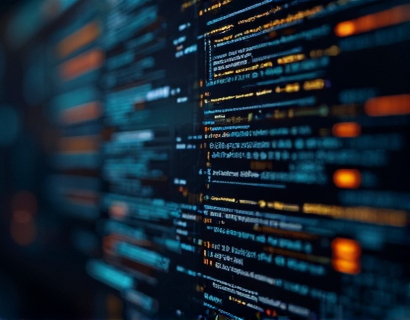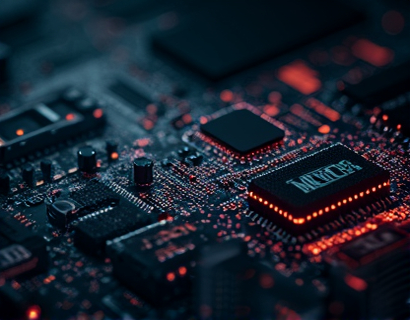Elevate Your EVM-Based Blockchain Projects: Mastering Scalability with Advanced Layer 2 Solutions
In the rapidly evolving landscape of blockchain technology, Ethereum Virtual Machine (EVM)-based projects have become the cornerstone for developing decentralized applications (dApps). However, as these projects grow in complexity and user adoption, scalability emerges as a critical challenge. The inherent limitations of the EVM, particularly in terms of transaction throughput and gas costs, can hinder the performance and user experience of blockchain applications. To overcome these hurdles, integrating advanced Layer 2 (L2) solutions is essential. This article delves into the world of L2 solutions, focusing on how they can enhance scalability, security, and efficiency for developers creating EVM-based dApps, ultimately driving innovation in the blockchain sector.
Understanding the Limitations of EVM-Based Blockchains
The Ethereum network, while revolutionary, operates on a finite capacity. Each transaction on the EVM requires gas, a unit of measurement for computational effort, which is paid for in Ethereum (ETH). As the network's popularity surges, the demand for gas increases, leading to higher fees and slower transaction times. This bottleneck not only affects user experience but also limits the types of applications that can be built on the platform. For instance, real-time applications, such as gaming and financial services, require low latency and high throughput, which the current EVM setup struggles to provide.
Moreover, the security of EVM-based blockchains is paramount. While the EVM's smart contract execution environment is robust, the centralization of computation on a single chain can create single points of failure. Layer 2 solutions address this by offloading some of the computational load, thereby reducing the risk of network congestion and enhancing overall security.
What Are Layer 2 Solutions?
Layer 2 solutions refer to technologies built on top of the primary blockchain (Layer 1) to improve scalability and reduce costs. These solutions do not alter the underlying blockchain but instead create a secondary layer that processes transactions off-chain and periodically settles them on the main chain. This approach significantly reduces the load on the EVM, allowing for faster and cheaper transactions.
There are several types of Layer 2 solutions, each with its own mechanisms and use cases. Some of the most prominent include State Channels, Plasma, and Optimistic Rollups. Each of these solutions offers unique benefits and trade-offs, making them suitable for different types of applications and use cases.
State Channels
State channels are a peer-to-peer transaction channel that allows multiple parties to transact off-chain, with the final state being submitted to the main chain once the channel is closed. This method is highly efficient for applications that involve frequent, small transactions between a limited number of participants, such as gaming or micropayments.
One of the key advantages of state channels is their low transaction fees and near-instant confirmation times. However, they require all parties to be online simultaneously to finalize transactions, which can be a limitation for some use cases. Additionally, state channels are not suitable for applications with a large number of participants or those requiring public verifiability of transactions.
Plasma
Plasma is a scalability framework that involves creating a tree-like structure of child blocks attached to the main blockchain. Each child block can process multiple transactions independently, and only the root of the tree needs to be submitted to the main chain. This hierarchical structure significantly increases the network's transaction capacity.
Plasma offers high scalability and flexibility, making it suitable for a wide range of applications. However, it introduces complexity in terms of governance and security, as the integrity of child blocks depends on the trust in the parent chain. Additionally, the finality of transactions on Plasma can be slower compared to other L2 solutions.
Optimistic Rollups
Optimistic Rollups are another popular Layer 2 solution that bundles multiple transactions into a single transaction on the main chain. These solutions operate under the assumption that transactions are valid until proven otherwise. If a fraudulent transaction is detected, the rollup can be challenged and resolved through a dispute period.
Optimistic Rollups offer a balance between scalability and security. They can process thousands of transactions per second while maintaining low fees. However, they require a dispute mechanism, which can introduce some latency and complexity. Despite these challenges, Optimistic Rollups are widely adopted and have proven their effectiveness in various applications.
Enhancing Scalability with Layer 2 Solutions
Scalability is the primary driver for adopting Layer 2 solutions in EVM-based blockchain projects. By offloading transaction processing to a secondary layer, these solutions significantly increase the network's throughput. For developers, this means they can build more complex and feature-rich dApps without worrying about the underlying blockchain's performance constraints.
For instance, a gaming platform built on an EVM-based blockchain can experience lag and high fees during peak usage times. By integrating a state channel solution, the platform can handle a large number of transactions off-chain, ensuring smooth gameplay and minimal user friction. Similarly, financial dApps can benefit from lower transaction costs and faster confirmations, making them more accessible and user-friendly.
Moreover, Layer 2 solutions enable better resource utilization. By reducing the number of transactions processed on the main chain, the EVM can handle more complex smart contracts and computations efficiently. This not only improves the overall performance of the blockchain but also reduces the risk of network congestion and increased gas fees.
Ensuring Security with Layer 2 Solutions
Security is a critical concern when integrating Layer 2 solutions into EVM-based projects. While these solutions offload some computational tasks, they introduce new security considerations that must be carefully managed.
State channels, for example, require secure key management to prevent unauthorized access to the transaction channel. Implementing robust cryptographic protocols and ensuring secure communication channels are essential to maintaining the integrity of the off-chain transactions.
Plasma and Optimistic Rollups, while more complex, also prioritize security through various mechanisms. Plasma relies on the trust in the parent chain to ensure the finality of child blocks, while Optimistic Rollups use dispute mechanisms to challenge and resolve fraudulent transactions. These mechanisms, though adding some latency, provide a high level of security and trust in the system.
Developers must carefully evaluate the security implications of each L2 solution and implement best practices to mitigate risks. This includes regular audits, secure coding practices, and staying updated with the latest security research in the blockchain space.
Improving Efficiency with Layer 2 Solutions
Efficiency is another key benefit of adopting Layer 2 solutions. By reducing the load on the main chain, these solutions lower transaction fees and improve confirmation times, making blockchain applications more accessible and cost-effective.
For developers, this means they can focus on building innovative features and user experiences without being constrained by the limitations of the underlying blockchain. Lower fees also make it more feasible to experiment with new ideas and iterate quickly, fostering a culture of innovation and rapid development.
Furthermore, the reduced latency associated with Layer 2 solutions enhances the user experience, especially for real-time applications. Users can enjoy seamless interactions without the delays and high costs associated with on-chain transactions. This is particularly important for applications in finance, gaming, and other time-sensitive domains.
Case Studies and Real-World Applications
Several successful projects have leveraged Layer 2 solutions to enhance their EVM-based blockchain applications. One notable example is the gaming platform Axie Infinity, which uses Optimistic Rollups to handle a massive number of transactions efficiently. This has enabled the platform to support a large community of players with low fees and fast transaction times, contributing to its widespread adoption.
Another example is the decentralized finance (DeFi) protocol Compound, which has integrated Optimistic Rollups to improve scalability and reduce costs for users. This has allowed Compound to offer a more robust and user-friendly platform for lending and borrowing crypto assets.
These case studies demonstrate the practical benefits of Layer 2 solutions in real-world scenarios, showcasing their potential to drive innovation and growth in the blockchain ecosystem.
Challenges and Considerations
While Layer 2 solutions offer significant advantages, there are challenges and considerations that developers must address. One of the primary challenges is the complexity of integrating L2 solutions into existing EVM-based projects. This requires a deep understanding of both the main chain and the L2 technology, as well as the ability to manage cross-chain interactions.
Another consideration is the ecosystem support and community adoption. The success of L2 solutions depends on the availability of tools, libraries, and community resources. Developers should look for solutions with strong community backing and a robust ecosystem to ensure long-term sustainability and support.
Additionally, the choice of L2 solution should align with the specific needs of the project. Each solution has its strengths and weaknesses, and what works for one application may not be suitable for another. Developers must carefully evaluate their use case and select the most appropriate L2 solution to achieve their goals.
Future Trends and Innovations
The landscape of Layer 2 solutions is rapidly evolving, with ongoing research and development pushing the boundaries of what is possible. One emerging trend is the integration of Layer 2 solutions with other blockchain technologies, such as sidechains and cross-chain interoperability protocols. These advancements aim to create more seamless and interconnected blockchain ecosystems.
Another area of innovation is the development of self-coordinating Layer 2 solutions, which automate the process of scaling and security without requiring active management. These solutions leverage advanced cryptographic techniques and smart contracts to ensure efficient and secure off-chain processing.
Furthermore, the rise of Layer 1 blockchains with built-in L2 capabilities, such as Ethereum 2.0 with its sharding and rollup layers, promises to further enhance scalability and efficiency. These native solutions are designed to work seamlessly with the main chain, providing a more integrated and robust scalability framework.
Conclusion
Elevating EVM-based blockchain projects through advanced Layer 2 solutions is a critical step towards realizing the full potential of decentralized applications. By addressing the challenges of scalability, security, and efficiency, L2 solutions enable developers to build more sophisticated and user-friendly dApps. Whether through state channels, Plasma, or Optimistic Rollups, these technologies offer a pathway to a more scalable and inclusive blockchain future.
As the blockchain ecosystem continues to evolve, the adoption and innovation of Layer 2 solutions will play a pivotal role in driving growth and adoption. Developers who embrace these technologies will be at the forefront of shaping the next generation of decentralized applications, paving the way for a more vibrant and resilient blockchain landscape.










































